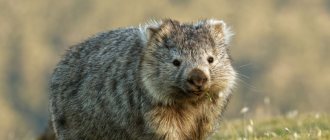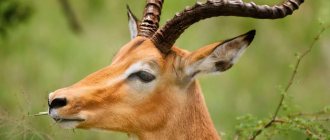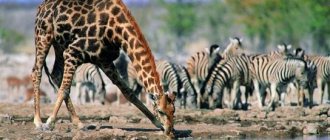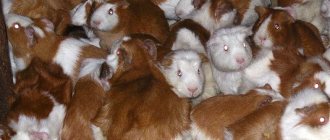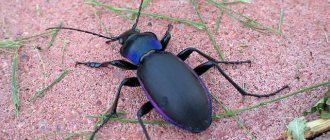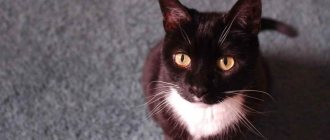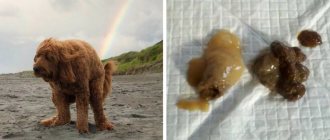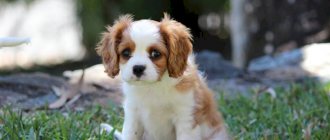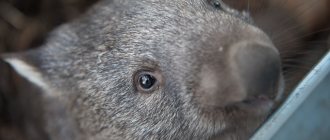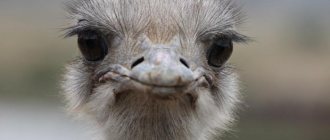Description of the species
Of course, wombats are far from bear cubs. They are very kind and seem to “smile” at people.
Sometimes they can be confused with koalas, moles or guinea pigs, but the essence remains the same - these rare animals have long been listed in the Red Book.
Small eyes and an elongated nose, an oblong head. The paws are short with long claws on five toes. With such limbs, wombats quickly and easily move through the ground to dig a hole.
The weight of marsupials is 30 - 40 kg, and they reach a length of 100 cm. The muzzle in the photo of the wombat is somewhat reminiscent of a snout, and its tail also looks like a pig’s - barely noticeable.
Buying a marsupial
This is a very rare animal, and to buy it, you may have to travel halfway across the country, waiting for your turn for a month or two. Officially, the export of animals from Australia is prohibited, and only a large zoo can purchase them. Of course, don’t even try to look for ads on Avito, they don’t sell wombats by hand, it would be a scam.
Baby wombat and its mother
You will not find any recommendations for choosing a cub, the animal is too rare and there is not enough information; the overall picture has not yet emerged. The advice may be standard:
- Carefully examine the cub to ensure there are no injuries to the skin;
- Eyes and ears are clean;
- Not painful looking.
It’s hard to say about activity and smell; you’ll have to trust the breeder. If possible, look at the wombat’s parents, the living conditions, and how pleasant the breeder is to communicate with.
The price of the animal is also not clearly defined, but varies within 50,000 rubles.
Apartment life
It was already mentioned above that wombats are practically untameable. Firstly, they are very stupid, it is useless to try to accustom them to a nickname, they will not respond anyway. There is not even any talk about basic training and commands. Secondly, although accidentally, they will damage furniture and floors with their clawed paws. They show aggression only when necessary; in normal situations they are kind and calm, but they can still injure a person, not on purpose. Therefore, families with children and elderly people should not have them.
Happy wombat
Wombats are indifferent to “bodily affection” from humans. It’s not that they don’t like to be petted, but they don’t show much enthusiasm like cats. They also don’t require any maintenance, the only thing is to let them eat and dig in the ground. Ideal conditions are a dacha, a garden plot, in general, not a home apartment.
Nutrition
The wombat feeds on roots, young shoots, berries, moss and mushrooms. In a word - herbivore. Their whole life comes down to searching for food, defending territory, and digging canals.
In search of food
It is noteworthy that wombats use energy very sparingly and can only eat a couple of times a month. They also require very little water. The arid climate of Australia dictates its own rules of survival.
And remember - we are responsible for those we have tamed!
Origin
Wombats are part of the natural heritage for a reason because of their ancient origins. Their first ancestors were animals living 18 million years ago. One of them is considered to be the marsupial Diprodon - the closest representative.
Interesting fact! The animals love privacy in their earthen burrows.
It is believed that the first wombat was brought to Australia by the navigator Matthew Flinders. The animal lived at his home and died 2 months later. Then Flinders froze the carcass and took it to his friend, British naturalist Joseph Banks, for research.
He gave him approximately the following description: “This animal digs the ground all the time, it has many habits similar to those of a bear. Perhaps he lived in a bear pack. When he's scared, he burrows into the ground like a badger. Most likely he is a type of badger.”
Habitat
Wombats are common in the southern and eastern parts of Australia, in the states of South Australia, Victoria, New Wales, Queensland and Tasmania. They inhabit a variety of habitats, but require soil suitable for burrowing. Wombats are the largest living mammals that dig and spend most of their lives underground. With their sharp claws, they dig out small living caves in the ground, which sometimes form complex tunnel systems. Typically, most of them reach about 20 meters in length and 3.5 meters in depth. If individuals' home ranges overlap, caves may be used by different wombats at different times. Wombats are active at night when they go out in search of food. During the day they rest in their shelters.
Appearance and features
Wombats are heat-loving animals, so they come out of their burrows during the day to feed and poop to mark their territory from enemies, and at night, especially during the cool period, they remain in the ground.
- Wombats, in their ability to live for a long time without moisture, are in second place after camels;
- the feces of these animals are square in shape;
- Wombats can live for a long time without food, as their digestive system digests what they eat for up to 2 weeks.
The strong paws of these guys are in constant motion. To do this, they need a lot of soil to feel comfortable, so they constantly loosen it. Their homes sometimes resemble entire labyrinths with “corridors” and caves.
The wombat animal is fully adapted to its habitat. The dry Australian monsoons are not debilitating for them. They can survive for a long time without moisture. Their slow metabolism is largely due to their less active lifestyle. They can stay in their burrow for weeks without needing food.
Animal lifestyle
The Australian inhabitant is predominantly nocturnal; during the daytime it rests in a hole. When the sun sets, it goes out in search of food. In winter, if there is a lack of heat, it can leave the home during the day in order to warm up. By the way, the wombat does not tolerate low temperatures.
To mark the territory (on stones, trunks of fallen trees), the marsupial uses its own feces, which, due to the specific structure of the anus, have a cubic shape. Sticky mucus and the specific sweetish smell of feces scare away competitors from an already occupied territory. By the way, in Australia, wombat feces are raw materials for paper production.
Where do they live?
The habitat of wombats is the southern parts of Australia, sometimes they can be found in Queensland, Wales and on the shores of Tasmania.
The main habitats of these unique animals in Australia are mountainous, forest and heather areas. You can also see animals living in Australia in Epping Forest National Park in Queensland.
Wombats love cool areas of the south; in the east, long-haired wombats have mastered Tasmania. The animals' favorite forests are eucalyptus, tropical forests, places near water bodies, and large meadows in alpine areas.
Despite the fact that Queensland wombats are hostile to herd animals, they adapt well to life in the home yard and get used to competition.
Northern wombats now live only in the Queensland National Park and are closely monitored by conservationists.
The southern species can currently be found in New Wales and southern Australia.
Diseases
Animals suffer the most from mites; they cause scabies. The disease leads to cracks in the skin, where infection enters. Therefore, after a tick bite, a rodent may even die.
Now Australians are trying to preserve these unique animals in nature and in zoos.
“Little Bears” are the wombats in the photo.
What do they eat?
Long-haired guys are very fond of young shoots of grass.
The length of a wombat's intestines is 12 times the length of its body. Therefore, food takes a long time to be absorbed. Poop cubes that don't fall from trees when an animal marks its territory.
The herbivorous wombat feeds on greens, root vegetables, berries, mushrooms, and also sorts through succulent mosses.
In culture[ | ]
| The section lacks links to sources. Information must be verifiable or it may be deleted. You can edit the article to add links to authoritative sources. This mark is set on August 13, 2022 . |
- A city, an asteroid, and a group are named after wombats; its name coincides with the name of an anti-tank gun.
- The wombat was kept at home by D. G. Rossetti. There is a widespread misconception[15] that it was this animal that became the prototype for Sonya from Alice in Wonderland. However, Rosetti got a wombat in 1869[16], 4 years after the fairy tale was published.
- Version 0.7 of the Arch Linux distribution had the new name "Wombat".
- Australian writer Ruth Park wrote the fairy tale "The Clueless Wombat". In 1991, the Ukranimafilm studio made an animated film of the same name based on this work[17].
- The tame wombat appears in the Australian children's adventure film Barney (1976) directed by David Waddington.
Features of character and lifestyle
Wombats love people and are drawn to them; they are very friendly in character, like animals “smiling” at people. They like to live in places where there are a lot of tourists to socialize and feast on hand.
But long-haired animals can be unpredictable, as they do not always correctly understand human intentions. Frightened by any unexpected movement, they can bite and even attack with their long and sharp claws.
Wombat, vombatiformes, are earth-moving animals. They build unique labyrinths underground to furnish their homes. Sometimes they have not only several branches, but also corridors and even floors.
A stranger cannot get into such underground jungle. A large animal simply gets stuck in a small hole, pinned down by the sharp paws of an agile wombat. And smaller enemies don’t even have time to go inside before the Australian bear cub simply attacks him from behind. The back of babies is very hard and does not give the attacker a chance to escape.
A wombat has an ass so hard it beats predators to death with it.
How a wombat defends itself is a story for a whole book. If animals made horror films about a house with traps, this would be the wombat's house.
Let's imagine the worst situation for a predator who decided to feast on a wombat.
You're a dingo dog, stupid enough to storm the furry bastard's hole. So, you see him at the entrance to his home and joyfully rush at the wombat, mistaking him for a defenseless victim. But it was not there! This bastard himself rushes towards you and scratches you with his front paws (very painful!), and then grabs you by the face (even more painful!).
Having delivered the first blows, the wombat turns away and runs to the hole. But he gets stuck in it like Winnie the Pooh, only in reverse: his butt sticks out, and his hind legs dangle hysterically and helplessly in the air. “Gotcha!”, you would decide. And they would be mistaken, because this is all a womb’s trick.
Once you come up and start biting his ass, it will turn out that it is impossible to bite through it. The wombat has a thick horny shield covered with thick hair on it. The dingo's teeth will simply click on it, like on a sewer hatch. In addition, the wombat begins to kick like a donkey. His legs are so powerful that in Australia they are on the prohibited weapons register!
Then the wombat, with a characteristic sound (“chponk!”), nevertheless flies into its hole and begins to run away. Imagine yourself in the place of a dingo: you have just had your nose bitten off and kicked in the face, but you simply have to take revenge on the furry asshole! But, without realizing it, you are plunging further into the lair of a dangerous psychopath.
While running away from you, the wombat will furiously fart right in your face, stunning and suffocating you. Then he will suddenly collapse the corridor behind him and a huge mass of earth will fall on you. Having barely gotten out from under it, you will find yourself alone with the owner of the dungeon. This is where you will come across his main weapon: it turns out that he can butt like a ram, and when the time comes for a fatality, he will begin to finish you off with his massive and hard ass.
A womb's ass that lands like a mace on your skull is the last thing you will see in your life.
Social structure and reproduction
Females are ready to breed at 3 years. The offspring are carried for about 20 days, after which the mother carries the pregnancy to term. The baby wombat stays in the pouch for another six months.
Aggression is observed both during competition between males and in their interaction during the sexual period. Females show interest in other individuals by entering their territory, while males sit proudly in their burrows.
The breeding season usually coincides with seasonal conditions. In dry and cold weather, individuals show little interest in each other.
Interesting fact! When females are ready to breed, they attract males by biting their tails.
Notes[ | ]
- ↑ 12
Family Vombatidae: [English] // Mammal Species of the World. — Bucknell University (Accessed: June 10, 2017). - Biological encyclopedic dictionary / Ch. ed. M. S. Gilyarov; Editorial team: A. A. Baev, G. G. Vinberg, G. A. Zavarzin and others - M.: Sov. encyclopedia, 1986. - P. 106. - 831 p. — 100,000 copies.
- ↑ 1 2 3 4 5 Sokolov V. E.
Five-language dictionary of animal names. Mammals. Latin, Russian, English, German, French. / under the general editorship of academician. V. E. Sokolova. - M.: Rus. lang., 1984. - P. 25. - 352 p. — 10,000 copies. - McDonald, 2007, p. 435.
- McDonald, 2007, p. 424.
- Long J., Archer M., Flannery T., Hand S.
Prehistoric Mammals of Australia and New Guinea: One Hundred Million Years of Evolution (English). - University of New South Wales, 2002. - P. 161-162. — ISBN 978-0-8018-7223-5. - ↑ 123
Common Wombat. Ballarat Wildlife Park. Access date: February 2, 2014. Archived February 3, 2014. - ↑ 123
https://zoograf.guru/drugie/vombat-opisanie-i-foto-zhivotnogo-gde-kupit-vombata.html zoograf.guru Website “All about pets” - ↑ 123
Encyclopedia of wild animals WildFauna.ru - Wombat - McIlroy, John.
The Encyclopedia of Mammals (unspecified) / Macdonald D.. - New York: Facts on File (English) (Russian, 1984. - pp. 876-877. - ISBN 0-87196-871-1. - There was a wombat here • Yulia Mikhnevich • Scientific picture of the day on “Elements” • Zoology
- Scientists understand why wombats have cube-shaped feces (English), BBC News Russian Service
(20 November 2018). Retrieved November 22, 2022. - Patrick the Wombat: [arch. 05/25/2017]. - Ballarat Wildlife Park. — Date of access: 10/15/2017.
- ↑ 12
McDonald, 2007, p. 425. - From the book “Memoirs of William Michael Rosetti” (1906)
- Rossetti's Wombat: A Pre-Raphaelite Obsession in Victorian England
- Filmography of the Ukraminafilm studio (unspecified)
(inaccessible link). Access date: August 1, 2012. Archived July 31, 2012.
Natural enemies
In adult life, the animals have almost no enemies. For now, the Queensland wombat can only fear two animals: the dingo and the Tasmanian devil. But they themselves suffer from the proximity of artiodactyls and habitat competitors - rabbits and sheep. They also often die under the wheels of cars.
Competitors of Australian animals, they are also warring brothers in their habitat - dingo dogs. It is difficult for wombats to cope with a larger animal of the canine family, but if he decides to climb into a hole, he will not be in trouble. With a massive back with long hair like needles, the small wombat squeezes the dog’s paws, thereby protecting itself and its home. His back is like a shield, capable of protecting the baby and driving the enemy into a corner.
Population and species status
As of 2003, the wombat population in Australia had dropped to 113 animals. There are only 30 females among them, which seriously threatens the extinction of the species. The Australian government is fully committed to protecting these rare animals. One of the species of wombats that is on the verge of complete extinction is the northern woolly-nosed wombat. At the moment they are in the Red Book. The population of other animals is slowly but surely growing.
The main factors negatively affecting the population of rare wombat species at the moment:
- Habitat reduction.
- Diseases.
- Enemies.
- Competing individuals in the territory of animals.
The species of the common wombat is not yet threatened; it reproduces well in the wild and in nurseries. But the southern woolly-nosed subspecies still causes little concern about population decline.
The problem of the development of occupational safety and health has been disrupted since European colonization. In 1925, there were hunting organizations that received money for killing wombats.
Description[ | ]
Externally, a wombat resembles a bear cub or a very large hamster. In terms of the structure of the body and individual parts of the body, it has much in common with the koala, but in reality their relationship is quite distant.
The wombat's body length is from 70 to 130 cm, weight is from 20 to 45 kg. The largest living wombat is the broad-fronted wombat. Among the extinct wombats there were species that were significantly larger in size than modern representatives of the family. Thus, Phascolonus gigas,
weighed about 200 kg[6].
The body is thick and compact. The head is large, gives the impression of being slightly flattened on the sides, the eyes are small, the ears are round, small, pressed to the head. The nose of the common wombat is naked, while that of other species is hairy. The tail is short. The limbs are short and strong, each of them has five fingers, of which the outer four are crowned with large claws adapted for digging the earth. The coat is dark, gray or brown, depending on the species.
The jaws and teeth of wombats show similarities to rodents. In the upper and lower rows, wombats have a pair of front cutting teeth. The chewing teeth are constructed very simply; there are no angular teeth. Wombats have the fewest teeth among marsupials - 12.
Wombats have a keen sense of hearing and smell, but rather poor vision. Despite their external clumsiness, they are very fast: to escape danger, a wombat can easily climb a tree, dive into a pond, or run away. They can run at speeds of up to 40 km/h, and over short distances reach speeds of 60 km/h[7][8].
Wombat is a valuable animal
The wombat is under state protection not only because of the problem of extinction of the species. In fact, this small, agile wombat is capable of digging and improving the soil. It can dig up to 4 tons of soil with its sharp paws.
Almost the entire lifestyle of the vombatiformes of these burrowing marsupials involves digging in the earth. Thanks to the work of these animals, vast areas of the earth are filled with nutrients, fertilizers, and moisture. During “excavations,” wombats fill the ground with new seeds, thereby increasing its fertility.
Characteristic
Because of its short legs, the wombat looks like a small, stocky bear. But in fact, he is a “relative” of the koala and the kangaroo.
Its body looks massive and thick, and thanks to its large head, the first Australian settlers called the wombat a badger.
Today, three species of these marsupial mammals are known:
- common Vombatus ursinus;
- broad-browed;
- Woolly-nosed Krefta, or northern.
Representatives of the last two species have another name - long-haired.
Albino wombats also exist, but they are extremely rare.
Important! Human agricultural activities have caused irreparable damage to the wombat population.
Interesting facts about the wombat
- The wombat is friendly and at the same time aggressive towards people; due to their unpredictability, you need to be careful with them.
- Wombat meat was a delicacy in Australia until the 20th century. Many meat dishes were made from it. After the ban on hunting animals was introduced, Australian cuisine began to consist of rabbit meat.
- At the Olympic Games in Sydney, the wombat was an unofficial amulet. The official symbols at that time were the three main mammals of the Australian range - the kookaburra, the platypus and the echidna.
- The wombat has its own birthday, which is celebrated in Australia on October 22.
- British and Russian-speaking rockers named their bands “Wombat” and “Stray Dog”.
- The reason why the wombat excretes square feces has not yet been clarified by scientists. It is believed that this is due to the structural features of the esophagus.
- The marsupial takes care of its offspring. Wombat mothers carefully take care of their young for a long time. Despite the fact that after birth they can develop independently, mothers carry “wombats” in their pouch for up to 11 months. They get food for their babies until they are completely ready for independence.
- The dimensions of the animal coincide with the parameters of a badger. Because of this, it is also called the “southern badger.”
Nutrition
They say about wombats that they are true gourmets and love only first-class food, which they obtain for themselves with the help of their claws. Wombats love to feast on young, succulent shoots of plants, as well as roots, mosses, some berries and mushrooms. To choose the best food for themselves, wombats use their sense of smell and the special structure of their lips and teeth.
Thus, they are able to cut off the smallest and most tender shoots at the root to enjoy their great taste. These unique animals digest food for up to 14 days, since they have an extremely slow digestion process.
Wombats are animals that do not need to absorb large amounts of water. In this way they are very similar to desert wanderers - camels. They only need 22 ml of water per day per 1 kg of weight. Therefore, the animal tolerates thirst quite easily, and can do without water for some time.
